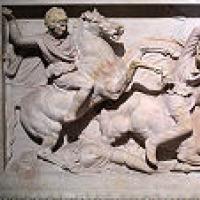Ok 7 ability to self-development and self-education. The main professional educational program of higher education. Passport and formation program
OK-7 the student must know:
1. Know: the place and role of philosophy in culture; the structure of philosophical knowledge; the problem of truth; lexical minimum of a foreign language of a general and professional nature.
2. Be able to: use the methods of scientific knowledge in the professional field; communicate with foreign colleagues on one of foreign languages, translate professional texts.
3. Own: methods of historical analysis and research; speaking skills in one of the foreign languages and professionally oriented translation of texts related to various types basic professional activity.
GPC-1 - the ability to use legal documents, international and domestic standards in the field information systems and technologies.
As a result of the development of competence OPK-1 the student must know:
1. Know: features of the application of regulatory legal documents in professional activities; regulations and requirements applicable to present stage development information technologies and software technological and functional standards that regulate the processes of design, construction and debugging of software; criteria, methods and models for assessing the quality and reliability of software.
2. Be able to: use regulatory legal documents in professional activities; determine and analyze criteria and methods for assessing the quality and reliability of software, implement models for assessing the quality and reliability of software.
3. Own: skills in applying functional and technological standards of tools; skills in using and applying the requirements of technological and functional standards, methods and models for assessing the quality and reliability of software tools to solve design and applied problems.
GPC-4 - the ability to solve standard tasks of professional activity based on information and bibliographic culture using information and communication technologies and taking into account the basic requirements information security.
As a result of the development of competence OPK-4 the student must know:
1. Know: theory and means of implementing modern information and communication technologies; general tasks of ensuring information security.
2. Be able to: formulate applied tasks taking into account the capabilities of modern information and communication technologies; independently master modern tools; organize the protection of information in the implementation of information processes (input, output, transfer, processing, accumulation, storage).
3. Own: skills in applying modern tools to solving applied problems; information security and information protection skills.
Type of activity - design
PC-1 - the ability to conduct a survey of organizations, identify the information needs of users, form requirements for the information system.
As a result of the development of competence PC-1 the student must know:
1. Know: theory, principles, methodology and technologies for designing information systems and the content of the stages of their development; methods for analyzing the subject area of information needs and forming requirements for the information system; methods and means of project management for the development of an information system.
2. Be able to: analyze the subject area, identify information needs and develop requirements for the information system; conduct comparative analysis and the choice of information and communication technologies to solve the development of information systems; to master modern tools independently.
3. Own: tools and standards for the development of technological documentation and project management for the development of information systems; skills in the use of modern tools for modeling the subject area, applied and information processes and designing information systems.
"Altai State Humanitarian and Pedagogical
named university »
(AGGPU im.)
PASSPORT AND FORMATION PROGRAM
general cultural competence OK-7
"the ability to self-organize and self-educate"
when mastering the OBEP HE, which implements the Federal State Educational Standard of HE
Direction of training 54.03.01 Design
Qualification (degree) of the graduate bachelor
Normative period of study 4 years
Biysk - 2016
PASSPORT AND FORMATION PROGRAM
students of general cultural competence
OK-7 - " ability for self-organization and self-education"
1. PASSPORT OF COMPETENCE
1.1. Definition, content and main essential characteristics of competence
The competence belongs to the category of higher education introduced by the federal state standard vocational education reflecting the specifics of the preparation of a bachelor graduate studying direction of preparation 54.03.01 Design. The formation of this competence is necessary when studying a separate part of the disciplines of the curriculum.
Competence OK-7 refers to the basic results of education. The formation of this competence is necessary for vocational training bachelor in the formation of systemic knowledge in the field of socio-pedagogical activity.
1.2. Competence structure
Bachelor
knows:
The norms of the culture of thinking, the foundations of logic, the norms of a critical approach, the foundations of the methodology of scientific knowledge, forms of analysis;
can:
Adequately perceive information, logically correctly, reasonably and clearly build oral and written speech, critically assess their strengths and weaknesses, analyze socially significant problems;
owns:
Goal setting skills, verbal and writing logically formalize the results of thinking, the skills of developing motivation to perform professional activities.
1.3. Planned levels of competence formation among university graduate students
Levels | Main |
Threshold | Knows the content of the processes of self-organization and self-education, their features (makes significant mistakes when disclosing the content and features of the processes of self-organization and self-education). Can: build a process of mastering the information selected and structured for the performance of professional activities (makes mistakes; has difficulty planning and setting priorities). owns technologies for organizing the process of self-education and self-organization (owns separate methods of self-education and self-regulation, makes mistakes in their implementation). |
Knows the content of the processes of self-organization and self-education, their features and implementation technologies, based on the goals of improving professional activities. (demonstrates knowledge of the content and features of the processes of self-organization and self-education, but provides an incomplete justification for the compliance of the selected technologies for implementing the processes with the goals of professional growth). Can: plan goals and set priorities in the implementation of activities; · independently build the process of mastering the information selected and structured for the performance of professional activities (it may be difficult to justify the chosen goals and priorities). owns technologies for organizing the process of self-education and self-organization. |
|
elevated | Knows the content of the processes of self-organization and self-education, their features and implementation technologies, based on the goals of improving professional activity. Can: plan goals and set priorities in the implementation of activities; · independently build the process of mastering the information selected and structured for the performance of professional activities. owns technologies for organizing the process of self-education and self-organization; methods of goal-setting in a time perspective, methods of planning, organization, self-control and self-assessment of activities. |
2. PASSPORT FOR FORMATION OF COMPETENCE
2.1. The necessary content of education to ensure the formation of competence:
The formation of the competence of OK-7 is carried out in accordance with the curriculum of the direction of training. Competence is formed in the process of mastering the disciplines of the basic and variable parts, passing training and industrial practices, performing research work .
2.2. The main ways, methods and technologies for the formation of this competence among university students in the development of OBEP HE
Lectures, practical, laboratory classes;
Performing written work (independent, control, laboratory work);
Practice;
Independent work of students;
Interactive forms of work (conversations, discussions, work in small groups, etc.);
Fulfillment of term papers and final qualifying works.
2.3. Stages of formation of a student's competence in mastering the main educational program
In the formation of the competence of OK-7 "ability for self-organization and self-education", the following stages can be distinguished:
First stage- associated with the study of disciplines (modules). As a result, the foundations for the application of competence in the conditions of solving professional problems are formed.
Second phase- is aimed at improving the skills and abilities defined by the competence in the course of educational and production practices in order to solve problems from the field of professional activity.
Third stage- is associated with the use and development of acquired knowledge, skills, skills, determined by competence, in the performance and defense of the final qualifying work.
Know:
Early concepts chemical bond. The main stages in the development of ideas about the chemical bond.
Schrödinger equation. The physical meaning of the wave function.
Structure electron shell atom. Connection periodic system and electronic structure of atoms.
Schrödinger equation for the hydrogen atom.
Forms atomic orbitals.
Methods of education covalent bond.
The method of valence bonds.
Types of hybridization of atomic electron orbitals.
Concepts: saturation of a covalent bond, bond energy, bond length, bond multiplicity, bond polarity.
Types of covalent molecules.
LCAO approximation for molecular orbitals. Substantiation of the LCAO method.
Ionic bond.
Structure and properties of ionic crystals.
Structure and properties of crystals of elementary substances.
Metal connection.
Types of intermolecular interactions.
General information about complex compounds.
The nature of the chemical bond in complex compounds.
The ligand field theory.
The theory of molecular orbitals of transition metal complexes.
Be able to:
Formulate the rules that determine the order in which electrons fill the orbitals of an atom.
Write down electronic formulas element atoms.
Write down structural formulas chemical compounds.
Describe the spatial structure of molecules.
find and explain essential features similarities and differences in the structure of molecules.
Predict the type of hybridization of valence orbitals.
Calculate bond length, covalent radii of atoms, covalent bond energy, standard heat of formation.
Calculate the effective charges on atoms.
On the basis of the electronic structure of molecules, explain the values of their dipole moments.
Apply the LCAO method to the description of molecules.
Draw energy diagrams of molecular orbitals for compounds. Using them to explain the properties of molecules.
Compare the structure of crystals various types with physical and chemical properties.
Draw a diagram of the distribution of electrons along the valence orbitals of the central atom in complexes.
Determine the geometric configuration of complex compounds and the type of hybridization of the orbitals of the central atom.
Determine whether the complex is: a) external or intraorbital; b) low or high spin; c) para- or diamagnetic.
Show by diagram the splitting of the d-sublevel of the central atom in octahedral and tetrahedral complexes.
Own:
special terminology.
Skills in constructing energy diagrams of molecular orbitals.
Skills in calculating the main parameters of a chemical bond.
The skills of presentation of theoretical material using visual aids, models of crystal lattices, reference data.



